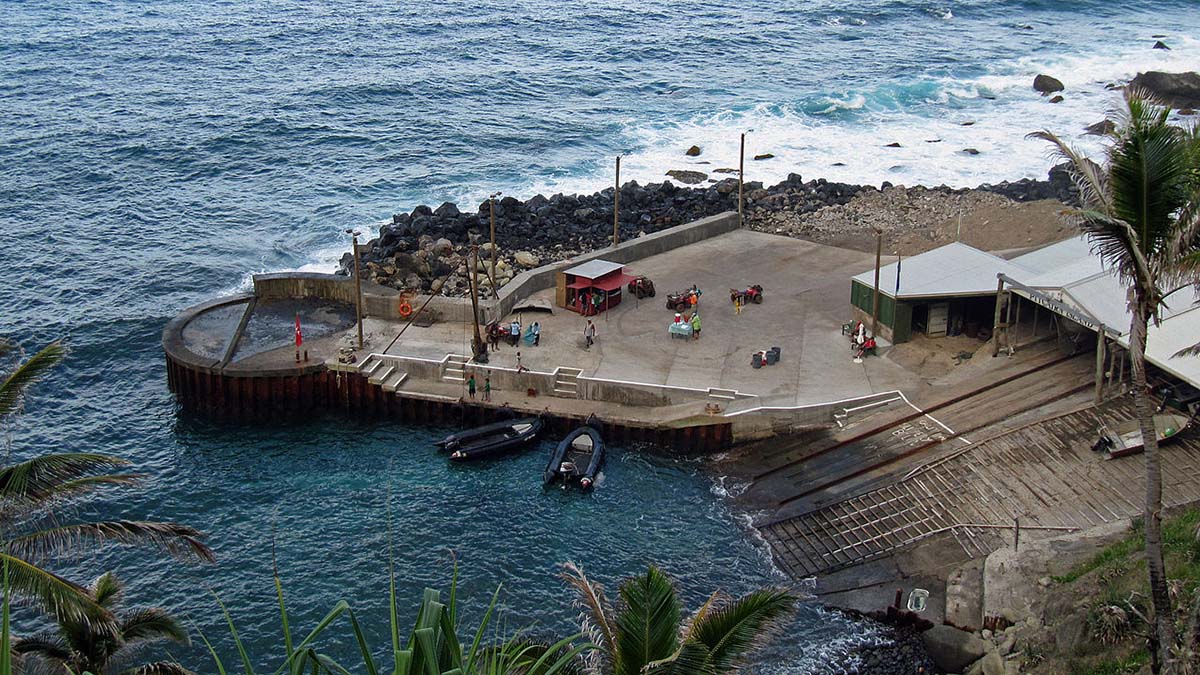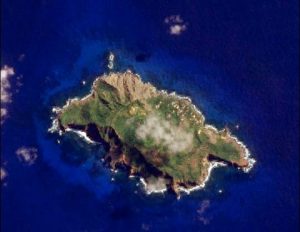
by Norman A. Rubin
 In 1790, near Tahiti Island in the South Pacific, English sailors staged a mutiny on the board the ship ‘HMS Bounty’. Nine English mutineers, their Polynesian ‘wives’ and a few Tahitian men and women took the Bounty on a desperate search for a safe hideout. They found it on Pitcairn Island. After being settled by mutineers, the island’s early history was bloody, with many feuds and violent deaths. Now Pitcairn Island is peaceful and its fifty families, many of them descendants of that infamous Bounty crew, welcome visitors to their idyllic tropical home.
In 1790, near Tahiti Island in the South Pacific, English sailors staged a mutiny on the board the ship ‘HMS Bounty’. Nine English mutineers, their Polynesian ‘wives’ and a few Tahitian men and women took the Bounty on a desperate search for a safe hideout. They found it on Pitcairn Island. After being settled by mutineers, the island’s early history was bloody, with many feuds and violent deaths. Now Pitcairn Island is peaceful and its fifty families, many of them descendants of that infamous Bounty crew, welcome visitors to their idyllic tropical home.
Over the years a trilogy of novels have been written about the fate of HMS Bounty and the mutineers including Mutiny on the “Bounty” (1932), Men Against the Sea, and Pitcairn’s Island) by Charles Nordhoff and James Norman Hall) and it has been dramatized in films. Now you can visit and explore the island and hear of the adventures from the descendants of the mutiny.
 The Pitcairn Islands group is a British Overseas Territory. It comprises the islands of Pitcairn, Henderson, Ducie and Oeno. Pitcairn, the only inhabited island, is a small volcanic outcrop situated in the South Pacific at latitude 25.04 south and longitude 130.06 west. It is roughly 2170km (1350 miles) east south-east of Tahiti. The island is approximately 3.2km (2 miles) long and 1.6km (1 mile) wide with the capital Adamstown located above Bounty Bay and accessed by the aptly named road, “The Hill of Difficulty”. Pitcairn Island was sighted on 3 July 1767 by the crew of the British sloop HMS Swallow, commanded by Captain Philip Carteret. It was named after Midshipman Robert Pitcairn, a fifteen-year-old crew member who was the first to sight the island. www.government.pn
The Pitcairn Islands group is a British Overseas Territory. It comprises the islands of Pitcairn, Henderson, Ducie and Oeno. Pitcairn, the only inhabited island, is a small volcanic outcrop situated in the South Pacific at latitude 25.04 south and longitude 130.06 west. It is roughly 2170km (1350 miles) east south-east of Tahiti. The island is approximately 3.2km (2 miles) long and 1.6km (1 mile) wide with the capital Adamstown located above Bounty Bay and accessed by the aptly named road, “The Hill of Difficulty”. Pitcairn Island was sighted on 3 July 1767 by the crew of the British sloop HMS Swallow, commanded by Captain Philip Carteret. It was named after Midshipman Robert Pitcairn, a fifteen-year-old crew member who was the first to sight the island. www.government.pn
The remoteness and ruggedness of Pitcairn’s geography, the insularity of its bureaucracy, and the scarcity of its resources conspire to make it a very difficult place to reach . Visitors who wish to stay on the island for any length of time require a license from the governor, because the irregularity of transport means they’re effectively residents of the island for the next several weeks or even months. These licenses require proof of good health, the means to leave at the end of the visit (e.g., passage on an upcoming ship), at least NZ$300/week to cover your cost of living on Pitcairn, plus various other conditions, and a $100 fee; these are valid for six months. admin@pitcairn.gov.pn

Cook Islands Cultural Village Tour with Night Show and Buffet Dinner in Rarotonga
If You Go:
Accommodation on the Island means “Home-stay” style. This is arranged prior to your arrival. Rates are Standard at US$70 per person per night. This includes all meals and laundry. Check with your host about rates for Telephone and Internet access. When you book your trip to Pitcairn you may contact individuals to book accommodation in advance otherwise the tourism co-ordinator will arrange home stay accommodation upon your arrival and introduce you to your hosts.
Pitcairn Islands Tourist Board
Adamstown, Pitcairn Island PCRN 1ZZ
(Pacific Ocean)
E-Mail: info@visitpitcairn.pn
Internet: www.visitpitcairn.pn
To get to Pitcairn today, you can travel on board Pitcairn’s new Passenger / Cargo supply ship chartered by the Pitcairn Island Government, the MV Claymore II. The Claymore II can accommodate 12 guests in private twin Cabins. Each cabin has two bunk style beds, table and chairs, wash basin, fans, reading lights, wardrobe and electrical outlet socket. The ship has air-conditioned passenger areas and provides guest with lots of room to relax outside on deck, watch a movie in the lounge or read a book on the enclosed, air-conditioned aft deck. All meals are served in the large dining room overlooking the front of the ship. The Claymore II sails direct to Pitcairn from the Island of Mangareva in the Gambier Islands, French Polynesia., a 32 hour journey. One could opt for a three-day sojourn on Pitcairn Island or a ten to a three month stay with a return booking on the Claymore!! cargo boat. To book a passage on board the MV Claymore II Please contact the Pitcairn Island Office (PIO) in Auckland, New Zealand on +64 9 366 0186 or email on admin@pitcairn.gov.pn.
A Saulsalito, California company Ocean Voyages Inc. called organizes yacht charters from French Polynesia to the Pitcairn Island. Every year between January and April the Rarotonga-based research vessel ‘Bounty Bay’, arranges cruises from Mangareva Island to Pitcairn and Henderson Islands, and paying guests are welcome.
Ocean Voyages, Inc.
1709 Bridgeway, Sausalito, CA 94965
Ph: +001 (415) 332-4681
Fax: +001 (415) 332-7460
Email: sail@oceanvoyages.com
Pacific Expeditions Ltd
PO Box 3063, Rarotonga, Cook Islands
Email: info@pacific-expeditions.com
Website: www.pacific-expeditions.com
There is quite a variety of activities to do on the Pitcairn Islands. You can go swimming at St. Paul’s Pool, a tidal pool in Eastern Pitcairn, Oeno Island has the only sandy beaches suitable for swimming. Henderson Island is good for bird watching. You will get a chance to go roping the cliffs; then there is snorkeling or scuba diving among coral reefs and a few shipwrecks. Add to that there are the Polynesian rock carvings; and at the island’s museum there are the mutiny artifacts and the Bounty Bible,
Henderson Island is a UNESCO World Heritage Site with several endangered bird species. The island of Henderson supports a rich variety of animals in its nearly inaccessible interior, and also of supporting a small human population, but access is difficult, owing to its outer shores being steep limestone cliffs made of sharp coral.
For additional information contact:
Pitcairn Islands Administration
P.O.Box 105696, Auckland, New Zealand
Tel: (+64-9) 3660186 Auckland
Tel: (+872) 762337766 Inmersat Mini-M at Pitcairn
Fax: (+64-9) 3660187 Auckland
Fax: (+872) 762337767 Inmersat Mini-M at Pitcairn
E-Mail: admin@pitcairn.gov.pn
E-Mail: ppa.mailbox@fco.gov.uk (governor)
Internet: www.government.pn
Photo credits:
Pitcairn dock by Jens Bludau / CC BY-SA
Bounty mutiny illustration: Robert Dodd / Public domain
Pitcairn satellite image: NASA / Public domain
About the author:
Norman A. Rubin is a former correspondent for the Continental News Service (USA), now retired and busy writing articles and stories for Net sites and magazines worldwide – see www.Google.com under the author’s name for a review of his written work.




Leave a Reply
You must be logged in to post a comment.